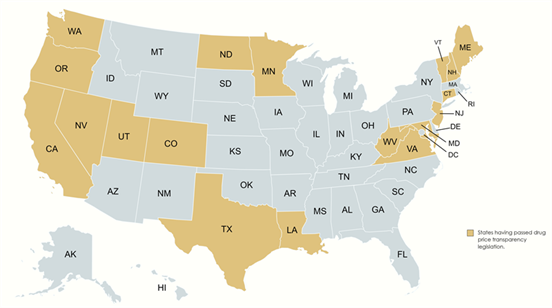While Congress may debate drug price transparency legislation, states are enacting their own drug price reporting requirements to curb rising drug prices. This GT Alert contains an overview of similarities and differences among and between state drug price transparency laws, as well as an overview of notable provisions in pending federal legislation.
An Overview of State Prescription Drug Price Transparency Laws
In the last five years, 18 states have passed legislation requiring prescription drug manufacturers to disclose certain price information for their drugs: California, Colorado, Connecticut, Louisiana, Maine, Maryland, Minnesota, New Hampshire, New Jersey, Nevada, North Dakota, Oregon, Texas, Utah, Vermont, Virginia, Washington, and West Virginia. These disclosures are intended to discourage high or increased prescription drug prices and, in turn, save federal and state health care dollars and lower prescription drug prices for consumers. However, these laws vary by state. This variability and complexity create challenges for manufacturer compliance efforts.

What to Disclose
“Drug pricing information,” otherwise known as “transparency,” is a broad concept; consequently, the scope of the various state requirements for disclosure varies markedly by state. States generally use one of three parameters to determine which drugs trigger reporting requirements.
-
Qualifying increases in a wholesale acquisition cost (WAC) over a relatively short period of time. For example, a state may require specified disclosures when a drug with a WAC greater than or equal to $100 for a 30-day supply increases by 10% or more in a year. However, the WAC threshold, the percent increase, and the applicable timeframe may be different depending on the state’s unique law.
-
WACs for new drugs that exceed the Medicare Part D Specialty Drug Rate, which is $670 in 2021.
-
Drugs that a state may specifically identify and/or publish. For example, Nevada publishes an Essential Drugs List and a Price Increase List. If a manufacturer’s drug is listed on either or both of these lists, the manufacturer must disclose specified information to the responsible state agency by the statutory deadline.
Once a drug satisfies one or more of the above reporting conditions, manufacturers must provide a range of information. Some states have relatively minimal disclosures while others have more rigorous disclosure regimes. For instance, some states require reporting of the WAC, the names of the drug and the manufacturer, whether the drug is brand or generic, and other basic information. Meanwhile, Oregon lists nineteen distinct disclosures ranging from basic information about the drug and the manufacturer to cost determination methodology and financial data if a drug’s WAC is $100 or more and the net yearly WAC increases by 10 percent or more. States in enacting laws have significant latitude to fashion their reporting requirements. Therefore, states may choose from an infinite number of disclosures, which states can tailor to specific reporting conditions.
How to Disclose
Reporting methods and technological infrastructure vary among states as well. Most states have implemented highly sophisticated online portals requiring manufacturers to register a user account, conform reportable information to specific file formats, and submit drug pricing information through the portal within a specific timeframe upon the occurrence of certain conditions. Some states make reporting templates available online and attachable to an email. Finally, some states have not fully implemented their required file exchange protocols due to either lack of funding or administrative delays caused by the COVID-19 public health emergency.
To Whom Manufacturers Should Disclose
The state administrative authority overseeing drug price reporting requirements varies by state. Some states have conferred authority to subdivisions within a state’s general department of health tasked with monitoring prescription drugs, health data, or health strategy, while others have delegated oversight authority to a board of pharmacy, a department of insurance, or an attorney general’s office. Colorado, however, requires disclosures directly to Colorado prescribers, rather than to a state agency. In conformity with confidentiality requirements, most state agencies publish the WAC metrics and other basic information received from manufacturers.
Potential Penalties for Non-Compliance
Most states impose monetary penalties for noncompliance with reporting requirements. However, some states impose daily caps, which range from $1,000 to $30,000 per day, while other states impose maximum penalties ranging from $200 to $20,000 per violation. Still other states impose no monetary penalties at all. Even with express penalties, some states grant their respective enforcement authority discretion when imposing, mitigating, or waiving a penalty. Finally, certain states specifically provide for appeal mechanisms for challenging the imposition of a penalty.
An Overview of H.R. 3: The Elijah E. Cummings Lower Drug Costs Now Act
Congress may also be taking steps to require transparency. On April 22, 2021, House Energy and Commerce Committee Chairman Frank Pallone (D-NJ) re-introduced the “Elijah E. Cummings Lower Drug Costs Now Act” (H.R. 3), which was originally introduced in 2019 but stalled in the Senate. The bill, currently undergoing committee markup, is significant in several respects. First, it may upend the historic ban on the federal government directly negotiating drug prices with manufacturers. Second, under Section 401, the bill may require manufacturers to notify and report certain information about both the prescription drug and the manufacturer to the U.S. Department of Health and Human Services (HHS). Notable reporting conditions and associated timing provisions, required disclosures, and potential penalties are outlined below.
| Condition | Timing |
| A qualifying drug’s estimated price for a year (or course of treatment) is $26,000 or more (on or after Jan. 1, 2023). | Within 30 days. |
| A qualifying drug’s WAC increases by 10% or more within a year (on or after Jan. 1, 2021). | No later than 30 days prior to the planned effective date of the increase. |
| A qualifying drug’s WAC increases by 25% or more within three years (on or after Jan. 1, 2021). | No later than 30 days prior to the planned effective date of the increase. |
| A qualifying drug’s WAC increases by 10% or more within a year (during the five years preceding Jan. 1, 2023). | No later than April 1, 2023. |
| A qualifying drug’s WAC increases by 25% or more within three years (beginning and ending during the five years preceding Jan. 1, 2023). | No later than April 1, 2023. |
| Contents of Required Disclosures | |||||||||||||
| For Each Qualifying Drug | For Each Manufacturer | ||||||||||||
|
|
||||||||||||
| Potential Penalties for Non-Compliance |
|
Conclusion
The landscape of prescription drug price transparency is complex and evolving. The independent criteria developed by 18 states and the potential enactment of a federal version with distinct obligations could pose logistical and compliance challenges for manufacturers seeking to adhere to the requirements of multiple jurisdictions.



 />i
/>i
